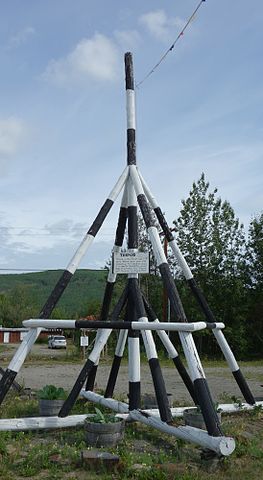The Ice Man Cometh
The Tenana River is a 584 mile (940 km) waterway flowing northwesterly in Alaska. It starts near the state’s border with Canada’s Yukon Territory and empties into the Yukon River in the center of the state. It’s not used much as a means for transportation during the winter, in part because the area it runs through is sparsely populated, and in part because around this time of year, it begins to freeze over. At one point, near the Alaskan city of Nenana, the ice reaches an average thickness of roughly 40 to 43 inches (about a meter).
At some point in the spring, the ice starts to melt. And when it does, someone wins big. Because since the early 1900s, Alaskans have been gambling on the event — a respite from the otherwise boring wait for a river to thaw.
The rules of what is now called the Nenana Ice Classic are simple — ante up, guess when the ice breaks, and win the pot. When the contest began in 1906, it was informally organized by the participants, a small group of about a half-dozen locals with the winner earning himself a few rounds of drinks. The contest wasn’t repeated until 1917, when a bunch of railroad workers rebooted it, collecting about $800 ($14,000 in today’s dollars) and earning themselves an audience of would-be participants in the process. It’s become a local phenomenon ever since.
Over the years, determining “when the ice breaks” has led to the invention seen below as a way to give a definitive and objective answer. After the river freezes, organizers put what they call the “tripod” (a misnomer, as it has four legs) on the ice. To play, participants simply buy a ticket and write the date and time — to the minute — that they think the tripod will move down the river. The tripod is connected to a clock and, once the tripod moves a large-enough amount, the clock stops and we’re left with our official winning time.

The event now is an annual fundraiser for local charities and has made some people rather well-off. Last year, the winning couple took home a $318,500 prize purse. (If you want to watch a time lapse video of the tripod going downstream, there’s one on YouTube, here.) That’s the win of a lifetime, for most.
But not for the 2012 winner. For him, it was the third win of a lifetime. That year, the prize went to a mental health technician named Tom Waters, who took home about $250,000 (after accounting for Federal taxes, apparently). For Waters, the victory was nothing new — he had shared the prize in both 1983 and 1979 before taking the whole thing in 2012. And in 2011, he came close to another victory — he was only a minute off. He had a system, one which is hard to argue with given the results.
Each year, he drills his own holes in the ice, hoping to gather data about the ice thickness and thaw rates of that season (without disturbing the tripod, of course). Then he does a bunch of math to narrow down the possibilities, and, once he has a small enough range, buys tickets. In 2011, he only bought ten tickets (at $2.50 each), even though in prior years he had bought hundreds. In 2012, he wasn’t about to miss out by a minute here or there, so he bought 2,000 tickets at the total price of $5,000. It took him an estimated 1,200 hours to determine the range — that’s roughly the equivalent of six months of full-time work (and so much time that he had to cancel his vacation to Hawaii) — so winning is a good deal, but hardly a great one.
As for 2013, Waters definitely participated to some degree but didn’t win. It’s not all that surprising — this year, the tripod moved at the latest recorded date in the Ice Classic’s history. And if you want to give Waters and the rest a run for their money in 2014? Tickets should go on sale around February 1, available here.
Bonus Fact: According to AMC, the river in Willy Wonka and the Chocolate Factory (the movie from 1971) was made from real chocolate — cream, water, and cocoa powder — plus shampoo.
From the Archives: Freezing to Un-Death: The frog that melts itself alive.
Related: Willy Wonka and the Chocolate Factory.
